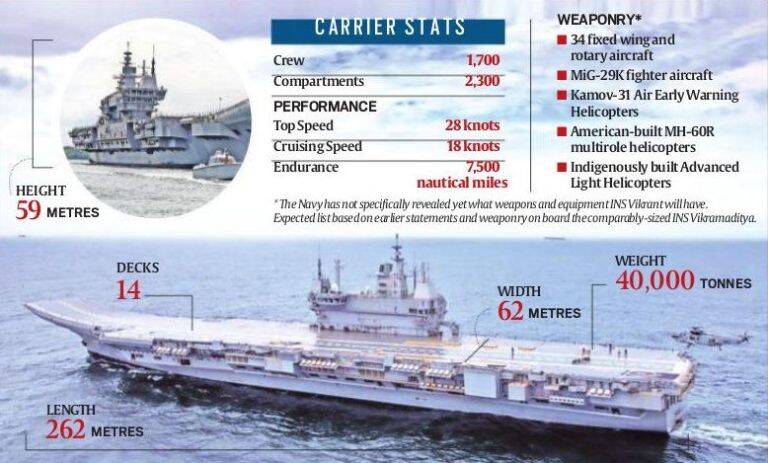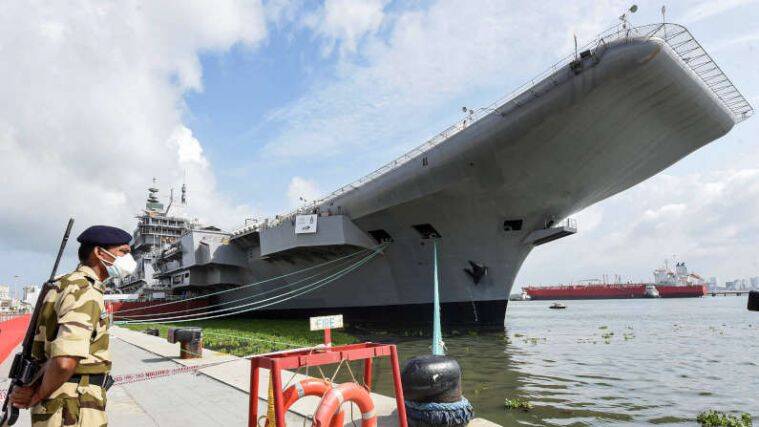The nation’s first Indigenous Aircraft Carrier (IAC-1) will be commissioned on September 2, the Indian Navy has announced. The commissioning of the warship, which will be christened ‘Vikrant’, will mark a “historical milestone of realisation of Nation’s commitment towards AatmaNirbharta” (self-reliance), the Navy said in an official release. Prime Minister Narendra Modi will be the chief guest on the occasion.
Vikrant is the largest warship to have ever been built in India, and the first indigenously designed and built aircraft carrier for the Indian Navy. It puts India in an elite club of nations that have the capability to design and build these giant, powerful warships.
The Navy took delivery of the warship, designed by the Warship Design Bureau (WDB), its in-house organisation, from the manufacturer, Cochin Shipyard Ltd (CSL), a public sector shipyard under Ministry of Ports, Shipping & Waterways, ahead of schedule on July 28. The ship had successfully completed its fourth and final phase of sea trials three weeks previously.
Why is it important for India to have an aircraft carrier?
An aircraft carrier is one of the most potent marine assets for any nation, which enhances a Navy’s capability to travel far from its home shores to carry out air domination operations.
Many experts consider having an aircraft carrier as essential to be considered a “blue water” navy — that is, a navy that has the capacity to project a nation’s strength and power across the high seas.
An aircraft carrier generally leads as the capital ship of a carrier strike/ battle group. As the aircraft carrier is a prized and sometimes vulnerable target, it is usually escorted in the group by destroyers, missile cruisers, frigates, submarines, and supply ships.
Why is it a big deal that this warship has been Made in India?
Only five or six nations currently have the capability of manufacturing an aircraft carrier, and India has joined this prestigious club now. Experts and Navy officials have said that India has demonstrated the capacity and self-reliance to build what is considered to be one of the most advanced and complex battleships in the world.
India has had aircraft carriers earlier too — but those were built either by the British or the Russians. The ‘INS Vikramaditya’, which was commissioned in 2013 and which is currently the Navy’s only aircraft carrier, started out as the Soviet-Russian warship ‘Admiral Gorshkov’.
India’s two earlier carriers, the ‘INS Vikrant’ and the ‘INS Viraat’, were originally the British-built ‘HMS Hercules’ and ‘HMS Hermes’. These two warships were commissioned into the Navy in 1961 and 1987 respectively.

Why will the new warship IAC-1 be named ‘INS Vikrant’?
The name ‘INS Vikrant’ originally belonged to India’s much-loved first aircraft carrier, a source of immense national pride over several decades of service before it was decommissioned in 1997.
The original ‘Vikrant’, a Majestic-class 19,500-tonne warship, which was acquired from the UK in 1961, played a stellar role in the 1971 War with Pakistan. India deployed the ‘Vikrant’ in the Bay of Bengal, and its two air squadrons of Sea Hawk fighter jets and Alize surveillance aircraft were used in strikes on ports, merchant ships, and other targets, and to prevent Pakistani forces from escaping through maritime routes.
Last year, as the IAC-1 started her first sea trial, the Navy hailed the “proud and historic day for India as the reincarnated ‘Vikrant’ sails for her maiden sea trials…, in the 50th year of her illustrious predecessor’s key role in victory in the 1971 war”. In its official release on August 25, the Navy said: “The induction and reincarnation of ‘Vikrant’ is…not only another step towards strengthening our defence preparedness but also our humble tribute to the sacrifices made by our freedom fighters for the independence of the nation and our brave soldiers during the 1971 war.”
What indigenous components does the new ‘Vikrant’ have?
The warship-grade steel required for the construction of the IAC-1 was indigenised through Steel Authority of India Limited (SAIL) in collaboration with Defence Research & Development Laboratory (DRDL) and the Indian Navy, the Navy said. It said that a major spin-off of building the indigenous aircraft carrier has been that the country has become self-sufficient with respect to warship steel.
The indigenous content of the project is approximately 76%, the Navy has said. This includes 23,000 tonnes of steel, 2,500 km of electric cables, 150 km of pipes, and 2,000 valves, and a wide range of finished products including rigid hull boats, galley equipment, air-conditioning and refrigeration plants, and steering gear.
According to the official release, major Indian industrial houses, viz., BEL, BHEL, GRSE, Keltron, Kirloskar, L&T, Wartsila India, etc., as well as over 100 MSMEs were involved in building of the indigenous equipment and machinery on board. The indigenisation efforts led to the development of ancillary industries, and generated employment opportunities for 2,000 CSL personnel and about 13,000 employees in ancillary industries, thus bolstering the plough-back effect on the nation’s economy, the release said.
The Navy had said earlier that more than 50 Indian manufacturers were directly involved in the project, and about 2,000 Indians received direct employment on board IAC-1 every day. Over 40,000 others were employed indirectly.
The Navy had said that about 80-85 per cent of the project cost of approximately Rs 23,000 crore had been ploughed back into the Indian economy.
What weapons and equipment will the new ‘Vikrant’ have?
The new warship is comparable to India’s existing carrier ‘INS Vikramaditya’, which is a 44,500-tonne vessel and can carry up to 34 aircraft, including both fighter jets and helicopters.
The Navy has said that once commissioned, IAC-1 will be “the most potent sea-based asset”. The official release on August 25 said the ship will be capable of operating 30 aircraft including MiG-29K fighter jets, Kamov-31 Air Early Warning Helicopters, MH-60R Seahawk multi-role helicopters, as well as the Advanced Light Helicopters (ALH) built by Bengaluru-based Hindustan Aeronautics Ltd, and the indigenously manufactured Light Combat Aircraft (LCA) (Navy).
Using a novel aircraft-operation mode known as Short Take Off But Arrested Recovery (STOBAR), the IAC is equipped with a ski-jump for launching aircraft, and a set of three ‘arrester wires’ for their recovery onboard, the release said.
The MiG-29K and Kamov-31 aircraft are already in use on the ‘Vikramaditya’. The MH-60R Seahawks are manufactured by the American aerospace and defence company Lockheed Martin. According to the Navy, the new warship will offer an “incomparable military instrument with its ability to project Air Power over long distances, including Air Interdiction, Anti-Surface Warfare, offensive and defensive Counter-Air, Airborne Anti-Submarine Warfare and Airborne Early Warning”.
What else will be there on the new ‘Vikrant’?
The 262 m long and 62 m wide ‘Vikrant’ displaces approximately 43,000 tonnes when fully loaded, and has a maximum designed speed of 28 knots (about 52 km/h) with an endurance of 7500 NM, the Navy said.
The ship has around 2,200 compartments designed for a crew of around 1,600, including specialised cabins to accommodate women officers and sailors. The carrier is designed with a very high degree of automation for machinery operations, ship navigation and survivability. The carrier is equipped with the latest state of the art equipment and systems. It boasts a fully-fledged state of the art medical complex with the latest medical equipment facilities including major modular OT, emergency modular OT, physiotherapy clinic, ICU, laboratories, CT scanner, X-Ray machines, dental complex, isolation ward and telemedicine facilities, the release said.
Now that India has shown the capability, will it build more carriers?
Since 2015, the Navy has been seeking approval to build a third aircraft carrier for the country, which, if approved, will become India’s second Indigenous Aircraft Carrier (IAC-2). This proposed carrier, to be named ‘INS Vishal’, is intended to be a giant 65,000-tonne vessel, much bigger than both IAC-1 and the ‘INS Vikramaditya’.
The Navy has been trying to convince the government of the “operational necessity” of having a third carrier. Former Chief of the Naval Staff Admiral Karambir Singh had said that the Navy could not remain a “tethered force”. Navy officials have argued that to project power, it is essential that India is able to venture far out on the oceans, which can be done best with an aircraft carrier.
For the government to be convinced of the need for IAC-2, however, a “change in mindset” is required, sources in the Navy had told The Indian Express earlier. The former Chief of Defence Staff General Bipin Rawat had spoken against investing in another aircraft carrier, and had suggested that the Lakshadweep and Andaman & Nicobar islands could instead be developed as “unsinkable” naval assets.
But Navy officials have said that to defend the vast Indian Ocean Region, persistent air power is required day and night. A third carrier will provide the Navy with surge capability, which will be essential in the future, they have argued.
Also, it is argued that now that India has developed the capability to build such vessels, it should not be whittled away. The expertise gained by the Navy and the country over the past 60 years in the “art of maritime aviation” should not be wasted either.
While the United States Navy has 11 aircraft carriers, China too is moving ahead aggressively with its aircraft carrier programme. It has two carriers now, a third is in the making, and another two are likely to be commissioned within a decade.
Navy officials point out that even if India gives the IAC-2 project the go-ahead now, it will be over 10 years before the warship is commissioned.
Source: Indian Express






